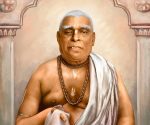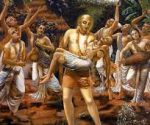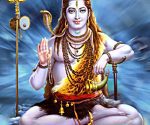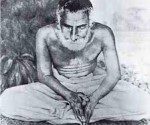Alloyed And Unalloyed Devotion
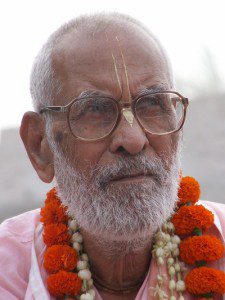
Sri Srimad Bhaktivedanta Narayana Gosvami Maharaja
(Most appearance and disappearance days in our Vaisnava calendar are observed in various countries on different days according to the local astrological timing: some holidays are observed over a two or three day period. This year, for most places of the world, this auspicious holy day (of Srila Bhaktivedanta Narayana Gosvami Maharaja disappearance day) is observed on December 11th.)
BY SRILA BHAKTIVEDANTA NARAYAN GOSVAMI MAHARAJA
![]()
Badger, California: May 19, 2003 Listen Attentively, our subject is now very exalted, and I request you all to hear this high, sweet and powerful tattva-katha very attentively. I know that some of the devotees will hear it, but will keep it in cold storage after I leave. Never keep it in cold storage. We should try to go over what we have discussed, again and again, in our minds. If anything else enters your mind just after hearing hari-katha and you focus on that thing, the hari-katha may leave your heart. In the evening, before going to sleep, you can remember all these topics and try to make them your own. I am giving all this especially for you, so you should try daily to remember what I have said and note it down in your heart. We are discussing very high topics.
We discussed the stages of bhakti leading up to bhava, and especially we have looked at the definition of bhava:
suddha-sattva visesatma
prema suryamsu samyabhak
rucibhis-citta-masrnya-
krd asau bhava ucyate
[“When devotional service is executed on the transcendental platform of pure goodness, it is like a ray of sunlight of love for Lord Krsna. At such a time, devotional service causes the heart to be softened by various tastes, and it is called bhava.” (Sri Bhakti-rasamrta-sindhu 1.3.1)]
This topic is elevated, and I think that a devotee who can explain it is extremely rare in this world. So try to hear very, very carefully. Bhakti is very rare. The bhakti we follow is not nirguna (without material qualities) or niropadhi (without material designations), but sopadhi (having designations). Very few can practice this bhava-bhakti, raganuga-bhakti. I want you to be able to enter into it, and therefore we will explain this subject gradually, using examples.
The definition of uttama-bhakti, pure devotional service is the barometer of bhakti.
anyabhilasita-sunyam
jnana-karmady-anavrtam
anukulyena krsnanu-
silanam bhaktir uttama
[“Uttama bhakti is the cultivation of activities that are meant exclusively for the benefit of Sri Krsna, in other words, the uninterrupted flow of service to Him, performed through all endeavors of the body, mind, and speech, and through the expression of various spiritual sentiments (bhavas). It is not covered by jnana (knowledge aimed at impersonal liberation) and karma (reward-seeking activity), yoga or austerities; and it is completely free from all desires other than the aspiration to bring happiness to Krsna.” (Sri Bhakti-rasamrta-sindhu 1.1.11)]
[On Srila Maharaja’s request, Srinivasa dasa, age 11, elucidates the meaning of this verse.]
[Srila Narayana Maharja:] Thank you. Very good explanation and pronunciation. I want all our boys to be like you. I became very happy to see that our teacher, Vrajendra-nandana Prabhu, is teaching the children nicely. I think that all the students will be jewels in the future. I’m very happy. I want all the boys to be like Srinivasa – very strong.
Sannyasis and brahmacaris should always remember one thing: the black, poisonous snake of attraction to the opposite sex that I told you about should not come and bite you. I always fear for you. That snake attacked Sri Narada Rsi, but he was very “tricky”; he fled to Vaikuntha, and to Goloka Vrndavana, and that snake could not go there. If you are not careful, it may catch any of you.
DADHICI AND HIS BONES
Regarding uttama-bhakti, we have discussed so many points, and I want you to be able to understand this topic through examples. I don’t know whether or not if you have heard of Dadhici Muni. Any Indian boy will be familiar with all these histories. There was an exalted rsi named Dadhici. When Vrtrasura became very furious and began his destructive activities, Indra approached Lord Brahma and asked him what should be done.
Brahma replied, “You should at once, without hesitation, go to Dadhici Muni and ask him for his bones. By the help of those bones Vrtrasura can be killed. The rsi should give you his bones immediately, while he is still alive.”
Indra was doubtful. “How will Dadhici Muni agree?” he asked.
“Just go to him. He knows everything.” Indra thus approached Dadhici Muni and begged him for his bones.
Dadhici began to laugh. “You demigods are all alike,” he said. “You are only concerned about your own interests. Do you realize how much pain this will cause me?” Still, Dadhici was ready to offer his bones to the demigods, and he told them to bring a big herd of cows and large quantities of yoghurt and sugar.” He mixed the yoghurt and sugar together, and smeared this over his whole body. The cows then began to lick his body until only his bones remained. How painful it was, but still Dadhici Muni did it.
He made a great sacrifice; yet, we don’t consider him to be a bhakta. His actions were sat-karma, not bhakti. They will take one to the heavenly planets one day, but not higher.
MAHARAJA SIBI OFFERS HIS LIFE
There was once a king named Maharaja Sibi who was performing many asvamedha-yajnas. Seeing this, Indra thought, “Oh, he will take over my post and my entire kingdom, and I’ll have to leave.” He wanted to stop Maharaja Sibi, and therefore he took the form of a powerful bird-of-prey, an eagle, and he turned Dharmaraja into a pigeon. The pigeon began to fly away, and Indra pursued it as an eagle. Trembling and short of breath, the pigeon flew into the lap of Sibi Maharaja. At once the eagle arrived and said to Sibi Maharaja, “Oh, this is my meal, my diet. You must give it to me or offer me something else to eat.”
Maharaja Sibi replied, “I cannot give you this bird. I can give you my own body and everything I own, but I cannot give you this pigeon, because it is surrendered to me. What can I give you instead?”
“Oh, you should give me your flesh, your meat, in equal amount to the weight of that pigeon.” A scale was at once brought and Sibi Maharaja cut out a large amount of flesh from his thigh and placed it on the scale. But the pigeon weighed the scale down. The king then severed his whole leg and placed it on the scale, but it was still not enough. He then cut off the other leg, and even his two arms, but the scale still would not balance. Sibi Maharaja then put himself on the scale, offering his life.
At this Indra and Dharmaraja revealed their true identities to the king, and Indra said, “We want to give you a boon for what you have just done, as long as you don’t ask for my kingdom. This is the only condition.” The king began to laugh. Dharmaraja said, “You are really the embodiment of dharma and you will go to the heavenly planets.”
This is all Maharaja Sibi attained. He suffered so much pain, but for this he only went to heaven. His sacrifice is also sat-karma, and has no relation with bhakti.
THE STORY OF KING HARISCANDRA
Do you know Maharaja Hariscandra? He sold his own wife and son Rohitasva, and then he also sold himself to a crematorium. How did this come about? Sri Visvamitra Muni, a very high-class devotee who performed immense service to Lord Rama, wanted Ramacandra to appear in Maharaja Hariscandra’s dynasty. He therefore wanted him to become a pure bhakta and not remain a sat-karmi. To achieve this he took away his entire kingdom and everything he owned. He arranged a situation whereby the king was forced to sell all his personal property, including his own wife and son, and finally himself.
One day, while Hariscandra was guarding the cremation ground, a very poisonous snake bit his son, who died. In the night, the boy’s mother Saibya took him to the crematorium and Hariscandra called out, “Who is there? You cannot cremate your dead without my permission. You must first pay the fee.” Lightning flashed and Hariscandra saw that it was the dead body of his own son, and he saw his wife crying bitterly. He was in dilemma, but he finally said, “You will have to pay some fee.” She had nothing with which to pay, so she took half of the veil she was wearing and handed it to him.
At once Dharmaraja and the demigods descended, accompanied by Visvamitra Rsi. “Rohitasva will be the king,” they declared, and the boy immediately returned to life. Visvamitra then said, “I took everything from you, so now I’m returning it. You should now enter the jungle and meditate upon God.”
At that time Maharaja Hariscandra was also a sat-karmi, not a bhakta, and Visvamitra wanted to sprinkle his mercy upon him. You should know that all these pious activities are merely types of karma. We should be very discriminating about this.
EKALAVYA, THE BLACK-HEARTED HUNTER
Then, do you know Ekalavya? He was a nisada, hunter, who was very black and tall. He went to the school of the Pandavas and Kauravas, and approached their teacher Dronacarya: “O Dronacarya, O Gurudeva, I want to learn archery from you. Please teach me.”
Dronacarya asked, “Who is your father?” When Ekalavya told him, Dronacarya replied, “I cannot teach you. Please return home.” Ekalavya could not understand why Dronacarya had said this. Dronacarya was thinking, “If I teach him archery, he will develop a hatred for Arjuna and try to kill him. He will even try to kill Lord Krsna.” Dronacarya knew this because he was a perfect guru in both archery and devotion.
After Dronacarya rejected him, Ekalavya returned to the forest and created a statue of him; and there he began to practice his skills. One day Dronacarya entered that part of the forest with the Kauravas and Pandavas – one hundred and five disciples in all. Suddenly a dog started barking, and in a moment they saw that the dog’s mouth was full of arrows and he could not bark. The arrows had covered his mouth, but without leaving a single scratch or drop of blood anywhere. Everyone was wondering who had accomplished this, and then they saw a very big and black person, a hunter, practicing archery. He had done it.
Dronacarya asked, “From whom have you learned to shoot arrows like this?”
“O Gurudeva, you are my Gurudeva. I have learned it from you.”
“If I am your acarya, then give me some daksina, donation,” Drona said. When a student becomes perfect in his studies he should pay his teacher some daksina.
“Whatever you want I will give you,” the hunter said.
“You should give me your right hand thumb, by which an archer releases his arrows.” At once, without delay, Ekalavya cut off his thumb and gave it to Dronacarya. Dronacarya happily took it and left. Why did he do this? He knew the mood of that bogus hunter.
Although he was now without a thumb, Ekalavya continued practicing archery and later fought against Krsna and Arjuna; and Krsna took His cakra and at once killed him. Some devotees name their disciples or sons “Ekalavya,” but they are ignorant. Ekalavya was not a devotee. You should judge a person’s level by the verse “anyabhilasita-sunyam.” This is the barometer of devotion.
THE DETERMINED BOY DHRUVA
Now we come to Dhruva Maharaja. [Speaking to Sripad Bhaktisar Maharaja] Explain the essence of Dhruva Maharaja’s life history, within two minutes.
[Sripad Bhaktisar Maharaja briefly narrates Dhruva’s life-story, explaining that we should have Dhruva’s forceful determination and practice under guidance, as Dhruva did, but we should not hold on to even a scent of material desire. Dhruva’s bhakti was not pure, and he thus had to accept the fruits of his desires: he reigned as king of this world for 36,000 years, after which he was elevated to a planet greater than Brahmaloka but situated within this material world.]
[Srila Narayana Maharaja:] You have heard the life history of Dhruva Maharaja, written in Srimad-Bhagavatam. You should know that he was not engaged in aropa-siddha-bhakti or sanga-siddha-bhakti. His bhakti was svarupa-siddha-bhakti. [*See endnotes] His guru was the highest class of guru, Sri Narada Rsi. Due to the mercy of his guru, Dhruva Maharaja had darsana of the Supreme Lord, Narayana, after only six months. There is no record of anyone getting the Lord’s darsana in such a short time, but Dhruva Maharaja attained this. His Guru is very exalted, and his nistha was very strong. Narada himself had come to him and, in order to test him, had given him so many reasons to return home. “Wild beasts will eat you,” he said. “Now you are only very little, merely a small boy. You should not act like this.”
“But I have to meet with Hari. I must find Him,” Dhruva insisted. At last Narada gave him a mantra and instruction on how to proceed. So his bhakti is not aropa-siddha.
Then what fault was there? Anyabhilasa, the desire for personal gain, was there. Therefore, when Lord Narayana appeared to him, without asking him what boon he desired he told him, “You will be king of the entire universe for 36,000 years.”
Dhruva immediately began to repent for his desires to rule a great kingdom, because the darsana of Lord Krsna or Lord Narayana is amoga, infallible. Something good must come of it. At once, by one glance of Narayana, Dhruva’s desires were washed away; but he was bound to be king because he was given this boon. Now he began to repent continuously. If one is the disciple of a bona fide, high-class Guru, by the Guru’s supreme power the disciple will go to Vaikuntha-loka and not to the heavenly planets. But Dhruva Maharaja had some worldly attachments; he was attached to his mother. He saw her as his siksa-guru, remembering that she had helped him, but there was some material attachment and therefore he was taken to Vaikuntha-loka within this universe.
What is it about Dhruva Maharaja’s bhakti that we don’t want to follow?
asraya laiya bhaje tare krsna nahi tyaje
ara saba mare akarana
[The Vaisnavas continually take shelter of Sri Krsna and worship Him, and never abandon Him. They are liberated souls, free from the cycle of birth and death. (Narottama dasa Thakura, Prarthana 44.1)]
What is the meaning? “Asraya” refers to Gurudeva, Srimati Radhika and the devotees. Those who have taken shelter of any bona fide Guru will not give up Lord Krsna. Somehow or other they will hold on to Him. Dhruva Maharaja took His shelter, but from very far away. Dhruva-loka, the planet he was given to rule, is always in the north, and this planet does not belong to this material world. It is partially transcendental. It is an abhasa, or shadow, of transcendence What service does Dhruva Maharaja have in Dhruva-loka? None. The moon, sun and other planets are orbiting him, but that is all..
Dhruva Maharaja has no service, whereas bhakti means “anukulyena krsnanu-silanam”, to serve Krsna in a favorable mood, continuously, and under guidance. Therefore high-class Vaisnavas in the line of Srila Rupa Gosvami do not accept Dhruva Maharaja’s bhakti. In Srila Sanatana Gosvami’s Sri Brhad-bhagavatamrtam, Dhruva’s stage of bhakti has not even been mentioned. Srila Sanatana Gosvami explains uttama-bhakti beginning with the jnani-bhakta, the pure devotee who has realized the Lord’s Godhood, and then progresses to the suddha-bhakta, premi-bhakta, premapara-bhakta, and prematura-bhakta. After this stage there are no more bhaktas; everyone serves Sri Krsna as His associate.
Srila Sanatana Gosvami has explained all these topics in Brhad-bhagavatamrtam, and without its help you cannot be a pure bhakta. Your bhakti cannot be unalloyed because you cannot decide what is bhakti and what is not. I am presently giving classes only from this grantha (transcendental literature) and you should know all the truths therein.
Gaura-premanande.
Endnote: Three Types of Bhakti:
One should also remember that bhakti is of three types: svarupa siddha (those endeavors which are purely constituted of uttama-bhakti), sanga-siddha (those endeavors which are associated with or favorable to the development of bhakti but not of themselves purely composed of bhakti), and aropa-siddha (those activities which although not consisting of pure bhakti, are designated as bhakti due to their being offered to the Supreme Lord).
Aropa-siddha-bhakti: Endeavors indirectly attributed with the quality of bhakti. Endeavors which by nature are not purely constituted of bhakti – that is, anukulya-krsnanusilana – and in which the performer, in order to fulfill his own purpose, offers his activities and their results to the Lord. This is called aropa-siddha-bhakti. In other words, because his activities are assigned (aropa) to the Supreme Lord, bhakti is attributed (aropita) to them.
Comment:
That bhakti in which there is a mixture of karma or desires for material enjoyment is called sakama-bhakti or saguna-bhakti. Without the assistance of bhakti, karma cannot yield any fruit. Knowing this, many persons offer their prescribed duties for the satisfaction of the Lord, in order that He might fulfill their extraneous desires. The activities of such persons are not svarupa-siddha-bhakti. Nonetheless, because they offer the fruit of their activity to the Lord, it is considered as a type of bhakti. Although their activities are offered for the satisfaction of the Lord, their motivation is that by pleasing Him, He may fulfill their extraneous desires. In this case their activities are attributed with the sense of bhakti. Therefore, such endeavors are known as aropa-siddha-bhakti.
Sanga-siddha-bhakti: Endeavors associated with or favorable to the cultivation of bhakti. There are other endeavors which, although not purely constituted of bhakti, anukulya-krsnanusilana, acquire a likeness to bhakti due to their being established as assistants to bhakti. Such endeavors are known as sanga-siddha-bhakti. An example of this is found in Srimad-Bhagavatam (11.3. 23-25) in the statement of Sri Prabuddha Muni to Maharaja Nimi:
“One should cultivate compassion towards others, friendliness, offering respect to others, cleanliness, austerity, tolerance, silence, study of the Vedas, simplicity, celibacy, non-violence, and so on. One should consider heat and cold, happiness and distress to be the same. One should perceive the presence of the Lord everywhere. One should live in a secluded place, renounce family attachments and remain satisfied with gain which comes of its own accord.”
Even though the behavior or practices described in this verse are not by nature purely constituted of bhakti, they are assistants to bhakti. Thus they are considered to be like associates of bhakti. If bhagavad-bhakti is removed from the twenty-six qualities mentioned, then Bhagavan has no direct relationship with the remaining qualities such as compassion, friendliness, tolerance, austerity, and so on. Only when these items exist as assistants to or associates of bhakti is their likeness to bhakti effected. Therefore, they are known as sanga-siddha-bhakti.
Svarupa-siddha-bhakti: Endeavors purely constituted of uttama-bhakti All favorable endeavors (cesta) such as sravana, kirtana, smarana, and so on, as well as the manifestation of the spiritual sentiments which occur beginning from the stage of bhava, which are completely devoid of all desires separate from Sri Krsna and which are freed from the coverings of jnana and karma are known as svarupa-siddha-bhakti. In other words all endeavors of the body, words and mind which are related to Sri Krsna and which are performed exclusively and directly for His pleasure without any interruption are known as svarupa-siddha-bhakti.
Therefore, in the conversation between Sri Caitanya Mahaprabhu and Srila Raya Ramananda found in Sri Caitanya-caritamrta, both aropa-siddha and sanga-siddha-bhakti have been described as external. (Sri Bhakti-rasamrta-sindhu-bindhu 17-19)]
Editorial advisors: Pujyapad Madhava Maharaja and Sripad Brajanatha dasa
Editor: Sundara-gopala dasa
Assistant editor: Syamarani dasi
Transcriber: Janaki dasi
Typist: Vasanti dasi




